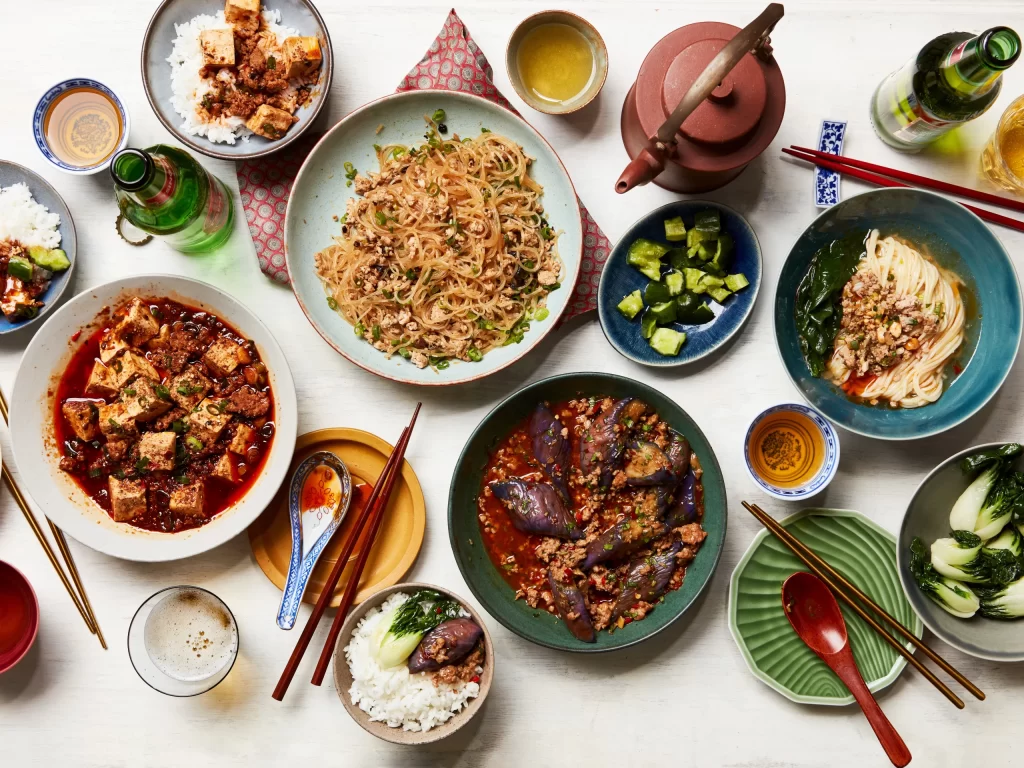Chinese Food Dishes for Family Dinner

Chinese Food Dishes for Family Dinner
Looking for a tasty and satisfying meal to share with your family? Chinese cuisine has you covered! Whether you love crispy spring rolls, savory dumplings, or sweet and sour chicken, Chinese food offers something for everyone. This article explores a range of delicious Chinese dishes that are ideal for a family dinner. From classic favorites to modern variations, these dishes are guaranteed to please everyone. Let’s explore the delightful world of Chinese dining.
Start Family Dinner with Chinese Food History
Chinese Food Cuisine From Pre-Tang Dynasty
The cuisine of the Pre-Tang Dynasty greatly influenced the development of Chinese culinary traditions. It introduced a variety of cooking techniques and ingredients still used today. Staple foods included rice, wheat, millet, and vegetables like cabbage, turnips, and radishes. Meats like pork, chicken, and fish were commonly consumed.
Regional Chinese cuisines added variety by using local ingredients and flavors. This resulted in a rich diversity of culinary experiences.
For example, in the north, wheat-based dishes were prevalent, while in the south, rice-based dishes were more common. Spices and cooking methods also varied by region, contributing to the unique culinary landscape of the time.
Post-Tang Dynasty Flavor Changes (Chinese Food)
The flavor changes in Chinese cuisine after the Tang Dynasty were significant. There was a focus on the balance of flavors, regional diversity, and the use of different cooking techniques.
This era saw an increase in the use of savory and sweet flavors, as well as greater emphasis on the balance between salty and spicy elements. There was also a wider adoption of regional cooking styles, leading to the development of various regional cuisines, each with its own unique flavors and ingredients.
The post-Tang Dynasty era also had a substantial impact on the use of vegetables, herbs, and seasonings, with an increased focus on incorporating a wide variety of fresh, locally available produce into dishes. This not only added depth and complexity to the flavors but also contributed to the health benefits of Chinese cuisine.
Choose Staple Chinese Foods for the Table
Rice Dishes That Everyone Loves
Classic rice dishes are loved all around the world. Fried rice, steamed jasmine rice, and sticky rice are some favorites. These dishes are versatile and go well with many flavors.
Different cultures influence how rice dishes are made and enjoyed. They bring unique seasonings, cooking methods, and ingredients. For example, Chinese fried rice uses soy sauce and Chinese sausage, while Indian biryani includes saffron and cardamom. These variations add richness to the flavors.
To make beloved rice dishes even better, one can try mixing flavors and using modern cooking techniques. For example, adding kimchi or chorizo to classic fried rice creates a new flavor. Using sous vide to cook jasmine rice gives it a fluffy and aromatic texture that enhances the dining experience.
Wheat and Noodles: A Versatile Choice
Wheat and noodles are used in many Chinese dishes because they can be cooked in different ways and combined with various flavors. They have been a key part of Chinese cuisine since the 3rd century. Noodles made from wheat are used in stir-fries, soups, and cold dishes. They can also be steamed, boiled, or deep-fried to create different tastes and textures.
This flexibility allows for the addition of ingredients like vegetables, meats, and sauces, making wheat and noodles essential in Chinese cooking. Their use has made Chinese cuisine diverse and popular worldwide.
Soybean Products: Tofu and More
Soybean products are important in Chinese cuisine. Tofu is a popular option, along with soy sauce, soy milk, and fermented soybean paste. These products add variety and flavor to meals. They can be prepared in different ways like frying, boiling, stewing, or grilling.
For example, tofu can be used in dishes like mapo tofu, hot and sour soup, or kung pao chicken, adding texture and absorbing flavors. Fermented soybean paste, or doubanjiang, enhances the taste of many Chinese dishes. Soy sauce is a staple condiment, used for seasoning and as a dipping sauce.
Add Variety with Regional Chinese Cuisines
Taste of Sichuan: Spicy and Bold
Sichuan cuisine is famous for its bold and spicy flavors. It uses ingredients like Sichuan peppercorn, chili peppers, and garlic. These give a numbing and spicy sensation unique to the region’s cuisine.
Compared to other Chinese cuisines, Sichuan dishes are hotter and more flavorful because of these spices. Traditional dishes like Mapo Tofu, Kung Pao Chicken, and Sichuan Hot Pot showcase the bold and spicy flavors of the region. They combine heat and rich umami flavors for an intense and satisfying culinary experience.
The mix of bold spices and complex flavors makes Sichuan cuisine stand out from other Chinese regional cuisines. It’s a top choice for those who want a truly memorable and fiery dining experience.
Cantonese Delights: Sweet and Light
Cantonese cuisine is famous for its delicious sweet and light dishes. Mango pudding, egg tarts, and sweet soups with red bean or lotus seeds are popular choices.
Unlike other Chinese cuisines, Cantonese food has milder flavors that focus on enhancing the natural taste of the ingredients. This makes Cantonese sweet dishes different from the bolder flavors found in other Chinese culinary traditions.
After a Cantonese meal, people commonly enjoy desserts and snacks like steamed sponge cakes, almond cookies, and sweet rice dumplings. These provide a delightful way to end a meal, balancing sweetness and lightness for a satisfying yet not overly heavy finish.
Vegetables and Herbs in Chinese Food
Popular Vegetables in Chinese Dishes
Popular vegetables in Chinese dishes include bok choy, Chinese broccoli, snow peas, and bamboo shoots. They are often stir-fried, steamed, or used in soups and noodle dishes.
Bok choy is used in various dishes, like stir-fries, where its crunchiness contrasts with other ingredients. Meanwhile, Chinese broccoli, known as gai lan, is found in a traditional noodle dish called “oi-meen,” with its slightly bitter taste.
Snow peas are included in stir-fries for their sweet flavor and crunchy texture. Lastly, bamboo shoots are used in both vegetarian and non-vegetarian dishes, adding earthy and crunchy hints.
These vegetables bring diverse flavors, textures, and nutritional benefits to traditional Chinese cuisine.
Herbs and Seasonings for Flavor
Chinese cuisine uses a few popular herbs and seasonings like ginger and garlic to add flavor.
Sichuan peppercorns are also common, providing a tingling sensation to dishes.
Different regions in China use these and other herbs to create unique flavors.
For instance, Sichuan dishes are known for being numbing and spicy, while Cantonese cuisine from Southern China tends to have a more delicate and mild flavor, using herbs like scallions and cilantro.
The diverse use of herbs and seasonings adds richness to Chinese cuisine.
Satisfy with Soups and Cold Dishes
Traditional Chinese cuisine has a wide range of soups and cold dishes suitable for different tastes. Examples include hot and sour soup and cucumber salad, which offer satisfying flavors and textures. In Chinese meals, these dishes can serve as appetizers to complement heavier main courses like stir-fries and noodle dishes, creating a balanced dining experience. For those who enjoy sweets, traditional Chinese desserts such as sesame balls and almond cookies provide a delightful end to the meal.
The variety and adaptability of Chinese soups, cold dishes, and desserts ensure satisfaction for every diner.
Enjoy Drinks with Chinese Food
Chinese cuisine has a wide variety of traditional drinks that pair perfectly with their flavorful dishes. Some popular options include hot tea, green tea, and cold herbal drinks.
The diverse range of flavors and textures in Chinese drinks can complement the rich and savory flavors of the food, creating a more enjoyable dining experience. For example, a hot tea can help cleanse the palate between bites of greasy or spicy dishes, while a cold herbal drink can provide a refreshing contrast to heavier meals.
In Chinese culture, it is common to share drinks with others at the table and to refill each other’s glasses as a sign of respect. Understanding these cultural and social norms can enhance the overall experience of enjoying drinks with Chinese food.
End with Desserts and Snacks
Traditional Chinese desserts and snacks are often sesame balls, red bean buns, and sweet rice cake. They can be a satisfying end to a meal. Fruits like lychee and longan are also commonly served for a refreshing finish. These items complement the flavors of a Chinese meal by offering sweetness to balance out the savory and umami flavors. Some desserts and snacks carry cultural or symbolic significance, like red bean buns that are believed to bring good luck and prosperity.
They hold importance in a Chinese meal by satisfying the palate and contributing to the overall dining experience.
Understand Dining Etiquette and Chinese Philosophy
Chinese food has changed a lot over the years. Different dynasties brought new flavors and foods. For example, during the Tang dynasty, people started adding sugar and fruit to savory dishes. In the Song dynasty, there was more meat and animal fat in the food.
In China, different regions have their own styles of cooking, like Sichuan, Cantonese, and Shandong. These regional cuisines add variety to family dinners and honor each region’s cultural heritage.
Chinese dining etiquette and philosophy influence the way dishes are chosen and presented during a meal. Traditionally, clear soups and cold dishes come before hot dishes. Tea or alcohol is served at the beginning of the meal and continues throughout.
Finally, fruits and sweet soup are often served as dessert to balance the flavors and aid digestion.
Summary
Find a variety of tasty Chinese food dishes perfect for a family dinner. From classics like sweet and sour chicken to more adventurous options like Peking duck, there’s something for everyone to enjoy.
Whether you’re looking for a quick and easy meal or a more elaborate feast, these dishes are sure to satisfy your family’s cravings for authentic Chinese cuisine.





